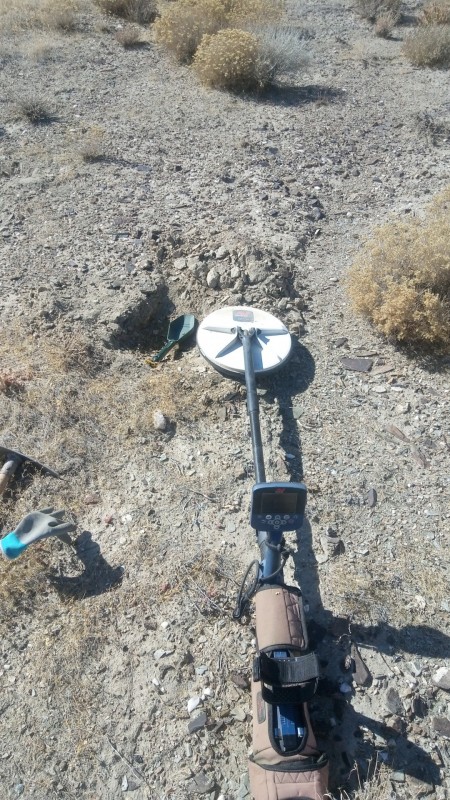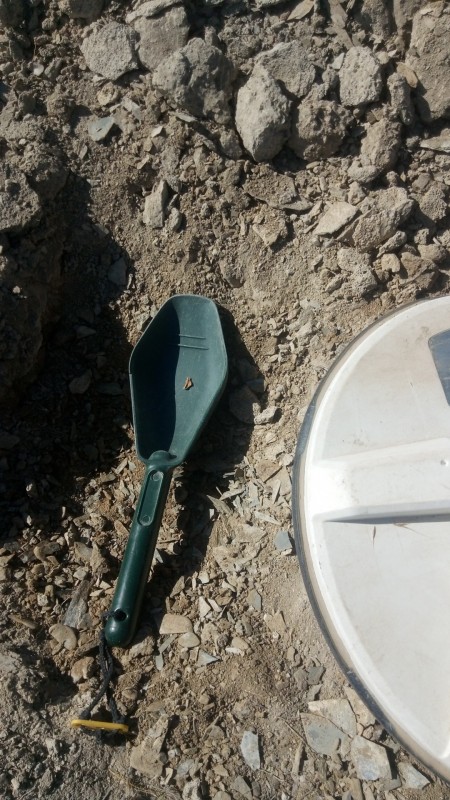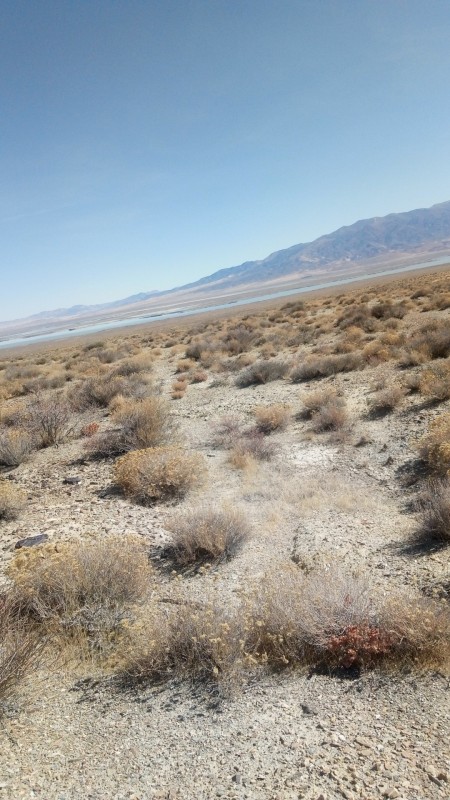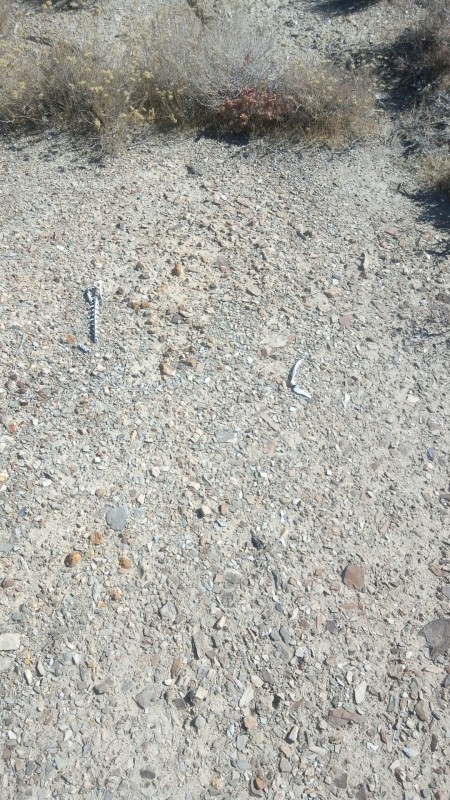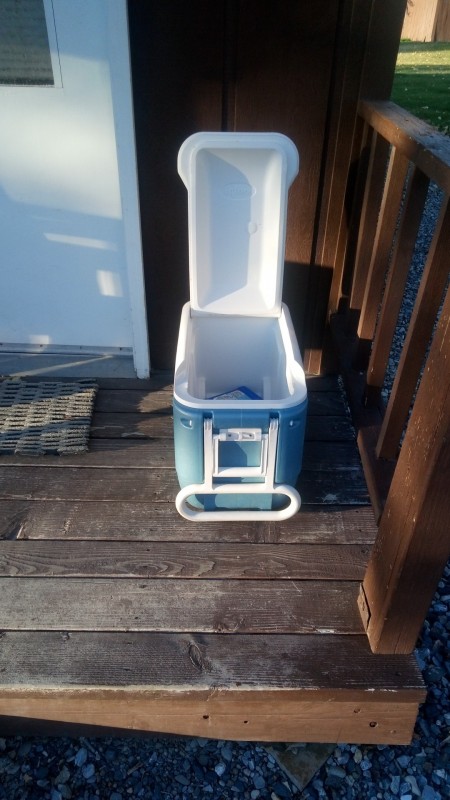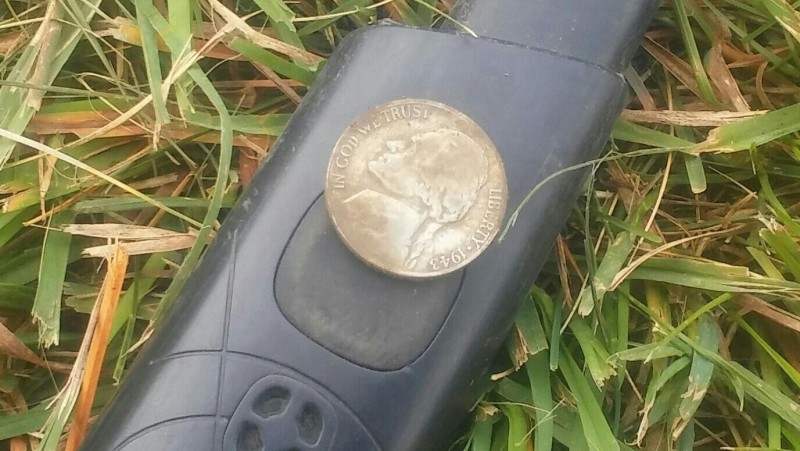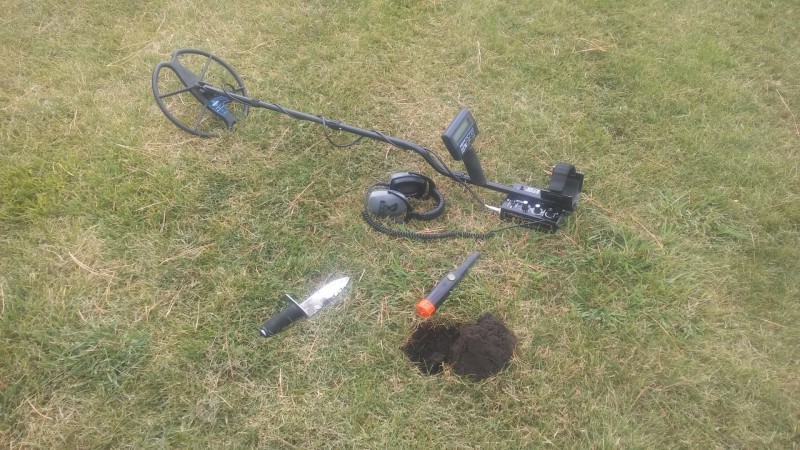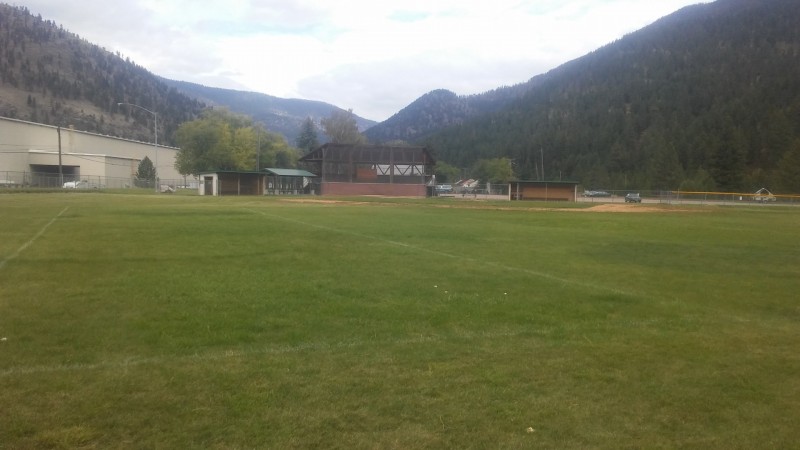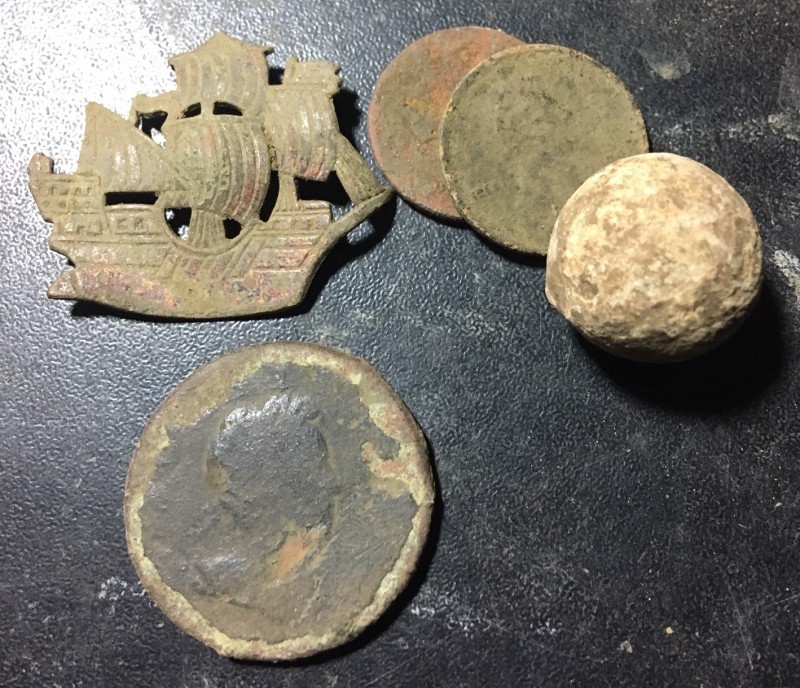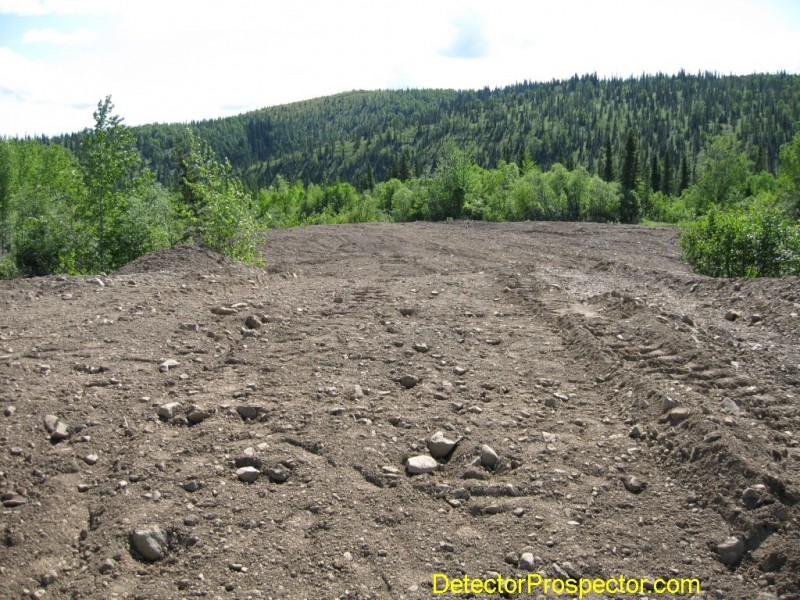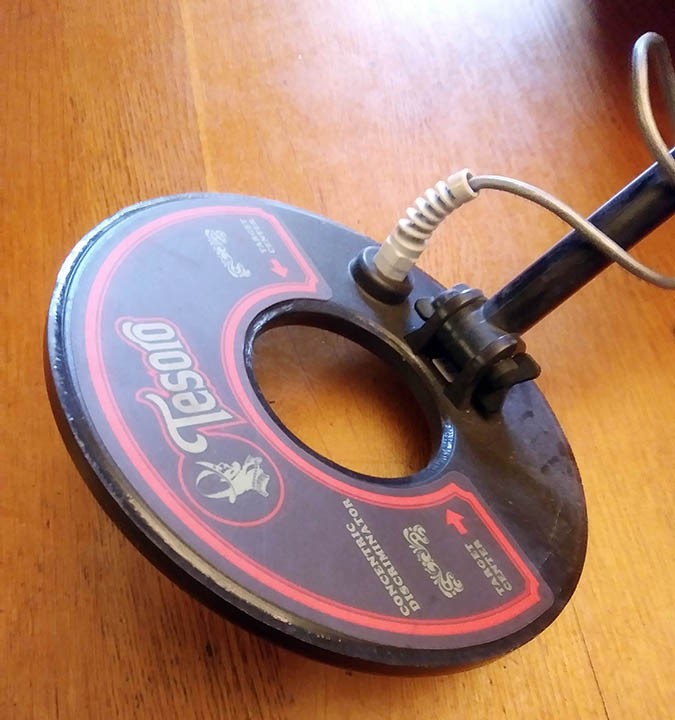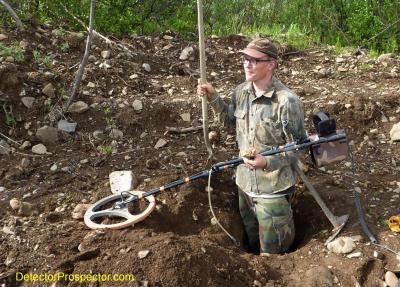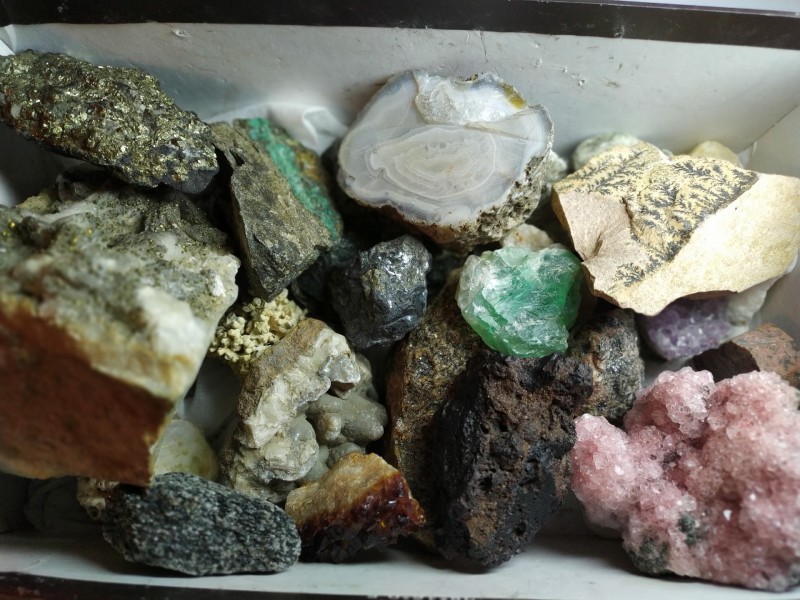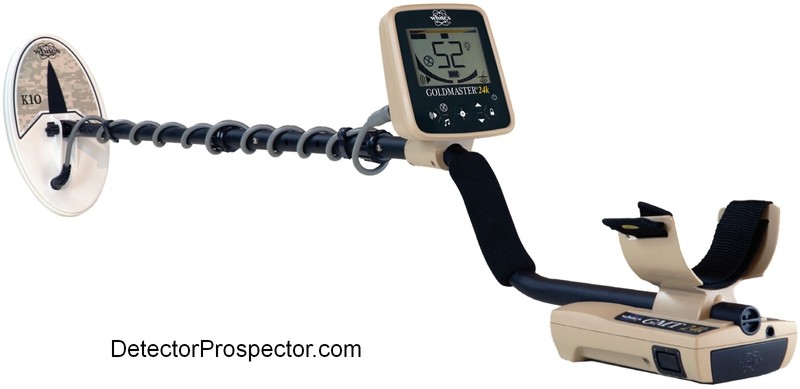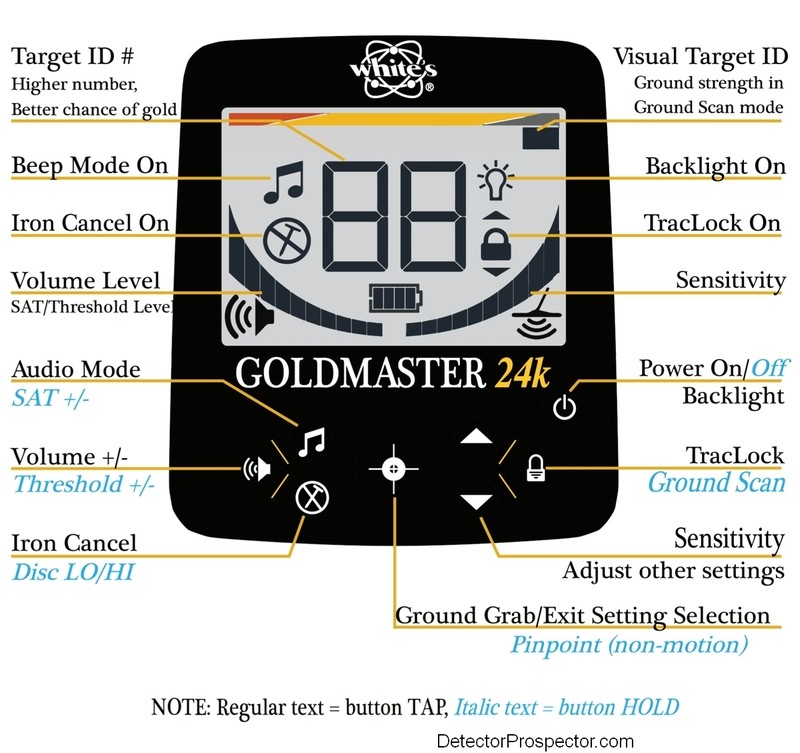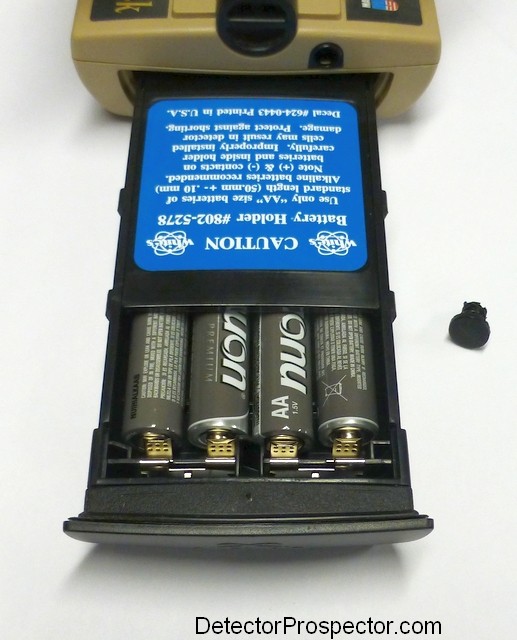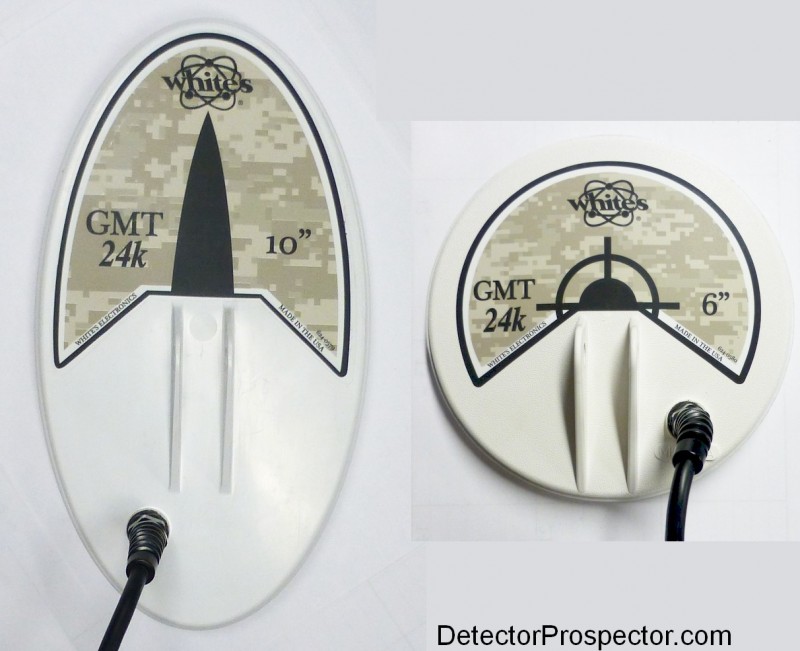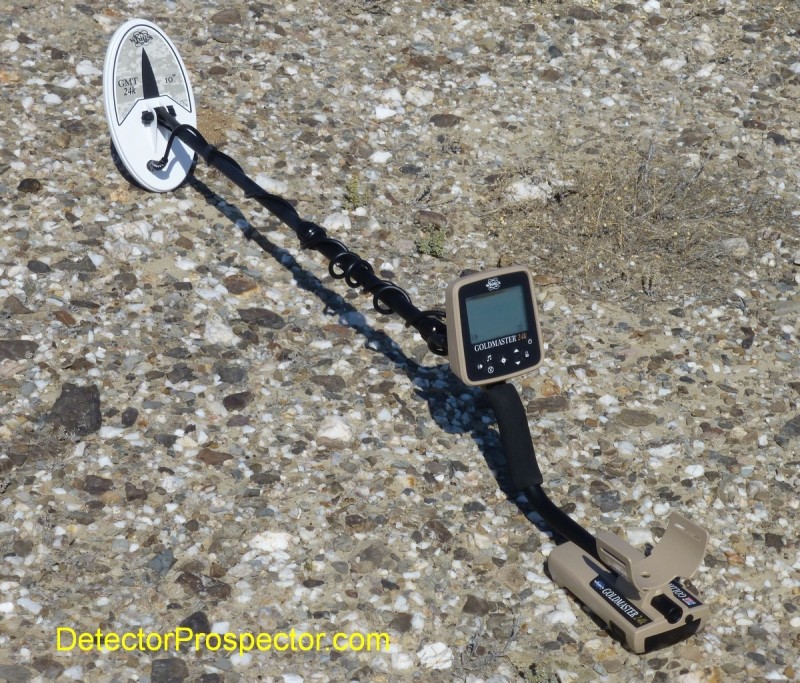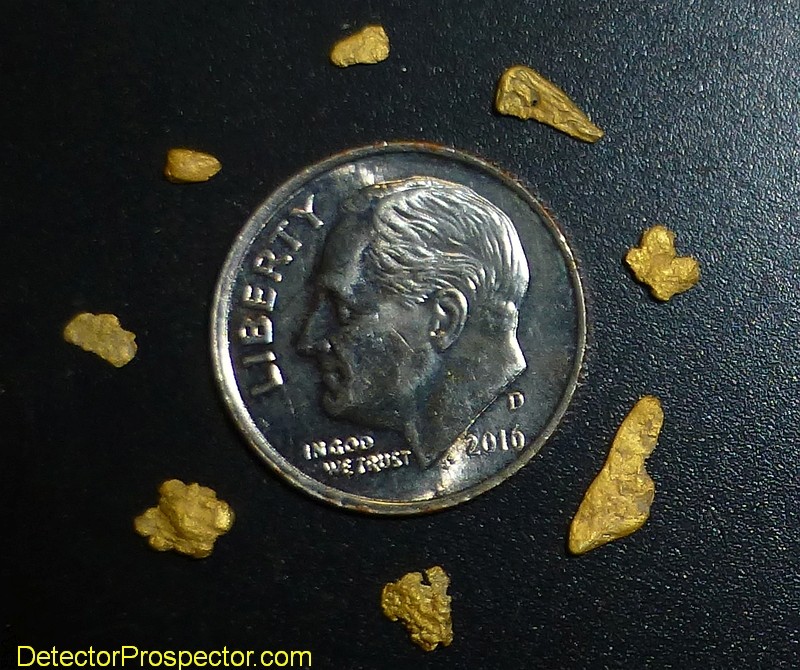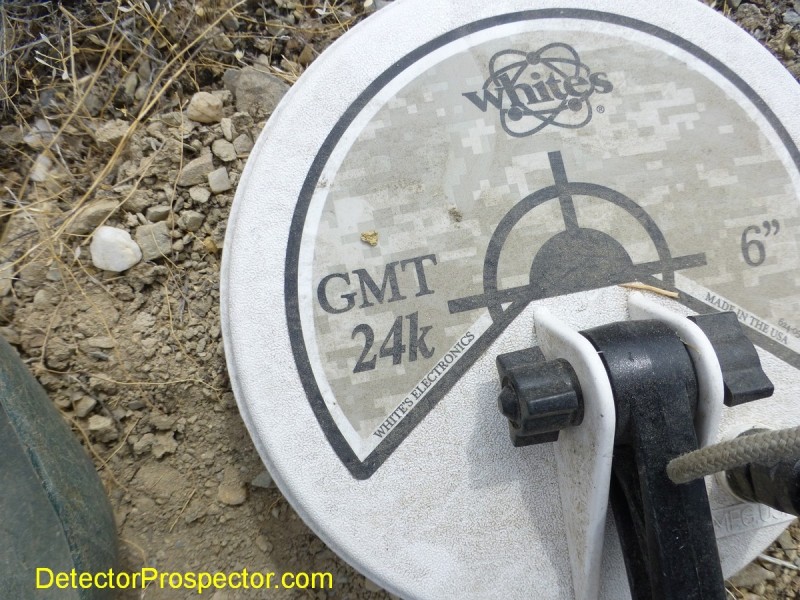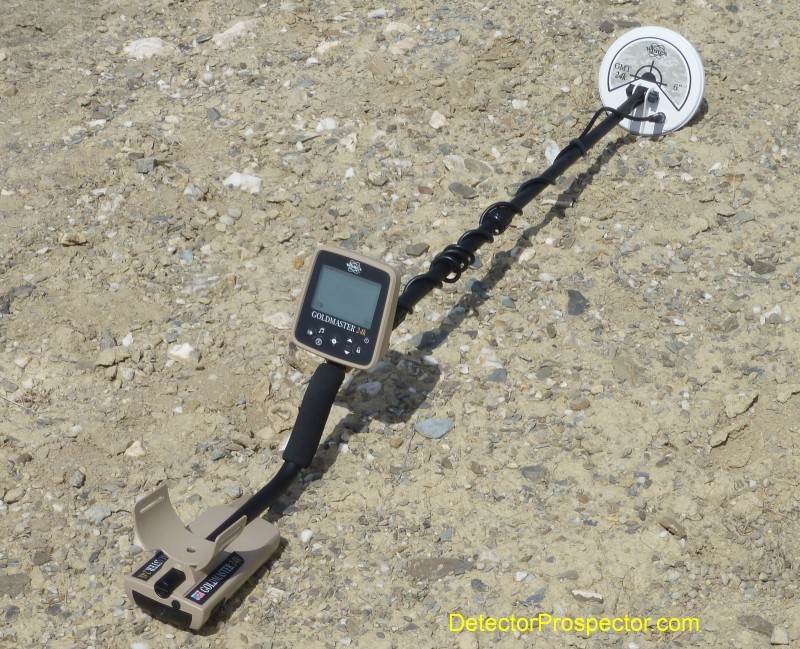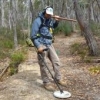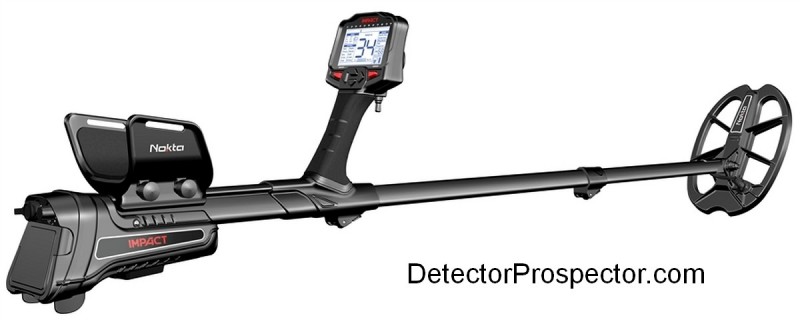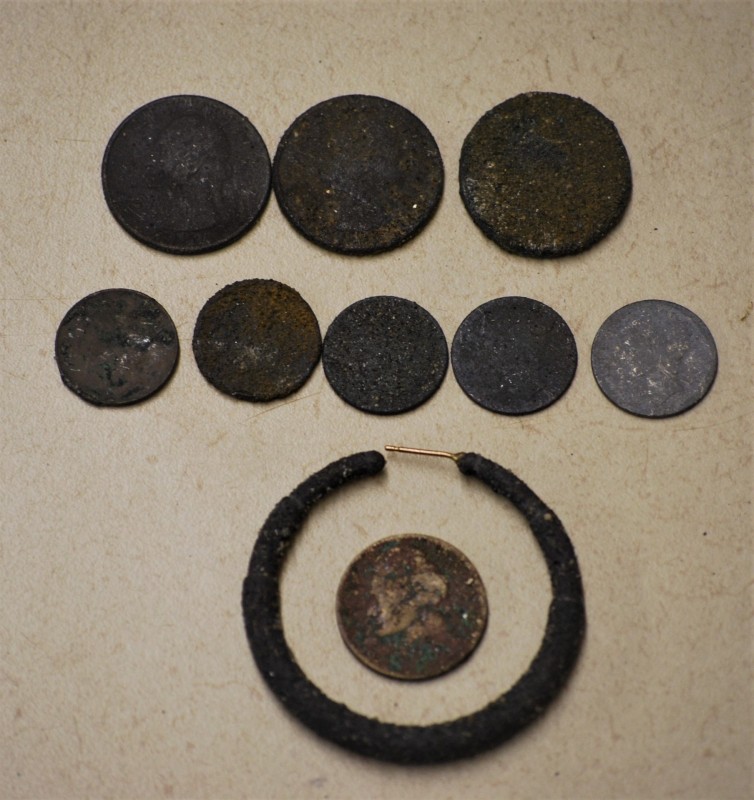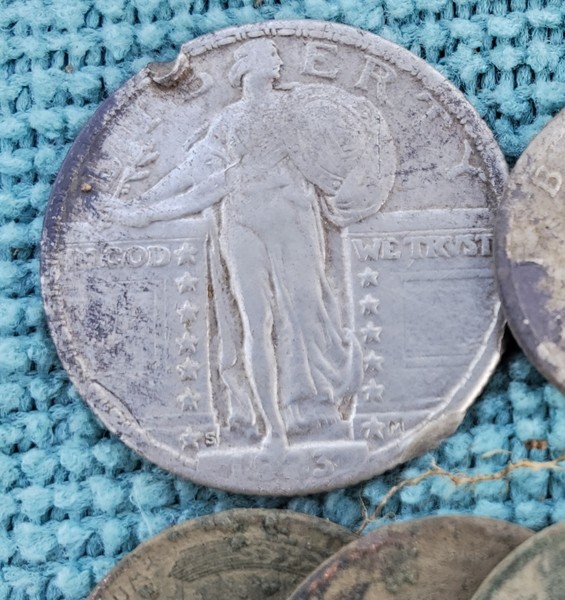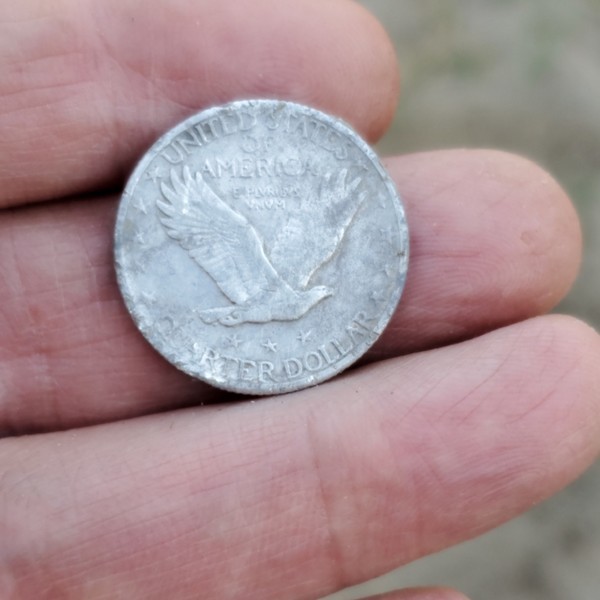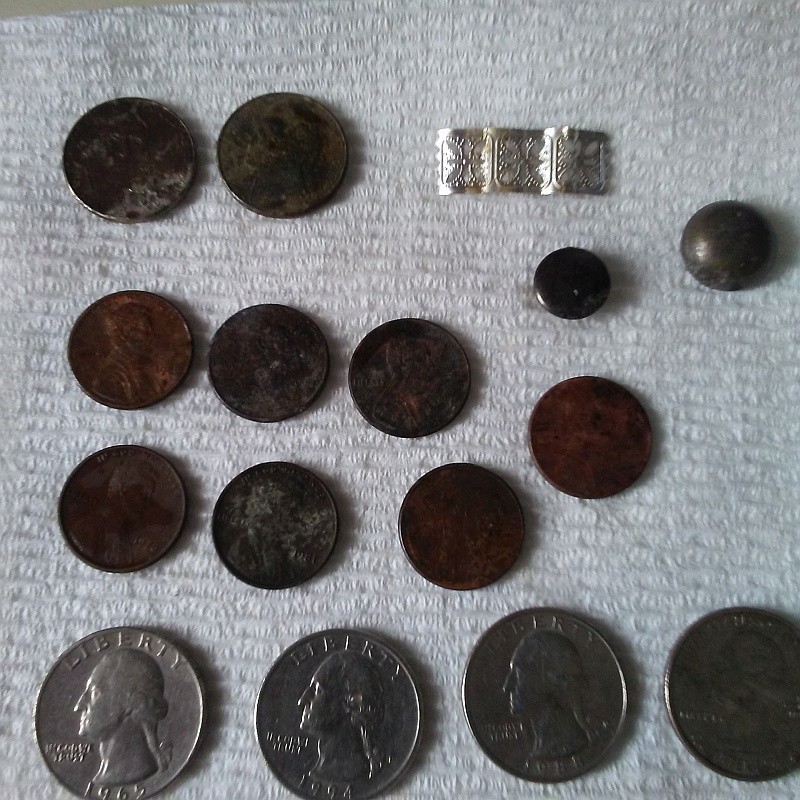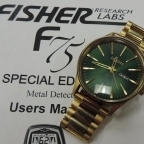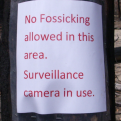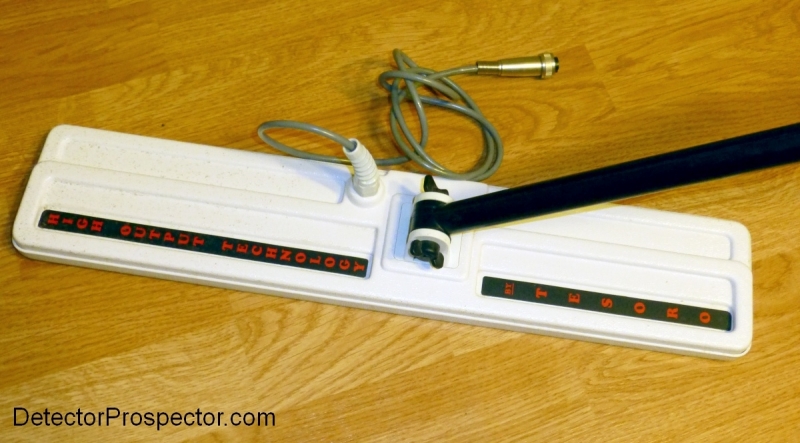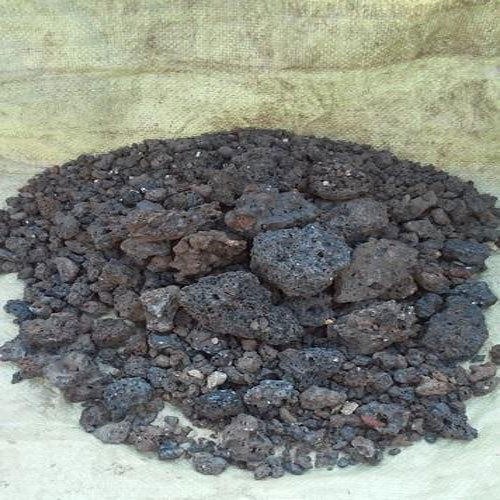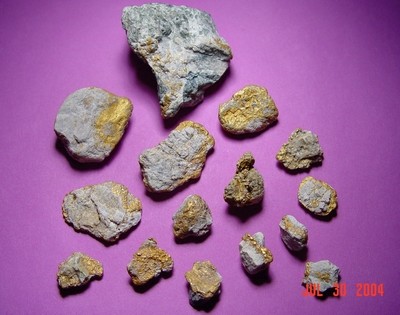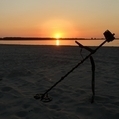Leaderboard
Popular Content
Showing content with the highest reputation on 10/14/2019 in all areas
-
It was time for another Rye Patch trip. It was a group outing this time and I had invited Chet. He was already there when I showed up out in the field about 3 on Wednesday afternoon. It was an 8.5 hour drive and I had added a couple of hours onto it getting checked in to my cabin but I was there! Chet had not found anything so he said I'll follow you. We got set up and he said he would catch up on some things and it was near the end of the day so I headed up. Before I got up too far my first target gave me that nice, warm sound. Even with the little sleep I had I thought it was a good target. I scraped and it didn't move and down a bit farther it didn't come out of the hole and then down about 7" I had it in the scoop. I sometimes overestimate so I put on my 7000 navigation that it was 1 gram but later not to be. It is just .72g. It is the nugget on the top left on the scale. I looked around the area and saw old dig holes so I knew I had to stay. I circled and gridded in the late afternoon sun and I got another signal. This one was a little deeper at 8". The size slightly larger at .75g. That was it for awhile until another repeatable signal. I don't remember the exact depth but I think 5" and I didn't really know if it was gold. It is and it is .11g! I didn't have my phone with me but that was it. I was beat and so was Chet so we took the 35 minute ride back to camp. Overnight it was pretty cold at 17-19 so I left the lid on my coolers open in my car and outside. When I got up the drinks had frozen in both of them but we were off for the same location. This time Chet hit the area where I found those three nuggets. I walked up the hill as I had intended. We didn't move the cars all day. Chet was working the little bowl and I was up on the sides of the big gully and anything else that looked promising. I heard a promising signal in a little dry, side run and it had shale type rock around but the signal would go away when I scraped and scratched. I was into some harder rock and it stayed and stayed and then I blasted it with my pick and it was out. It is the nugget in the middle. A solid 1.5 g nugget! I didn't have my phone with me as it was affecting my detector. Down in the distance I could see Chet working his 17" X Coil very slowly over and over the area from the day before. He had been digging some deep holes. When I made it down to him he said he had found one down about 10" that I didn't get. He also found another smaller one. In addition he had dug some really deep holes where some type of metal pieces had sounded off for him. It was a good day. I had a nice nugget and he had a couple. Friday we started at a different location but soon I wanted to get back to 'the area' but a bit higher. We both walked a long ways checking piles, pushes and holes. I was heading back up the hill and hear that nice sound again. This was only 4 inches or so and out came a nice flatter nugget (.84g). When I looked around I saw someone's recent filled in dig hole but they didn't get this nugget. The trash was hiding it! Things die out in the desert but not like they do in Australia! Australia is one big kangaroo graveyard! Here is the total for this trip. (I didn't find anything with a half day Saturday.) If I add in the two nuggets from my last trip then I have about 1/4 oz of Rye Patch gold. Thanks Chet for the companionship and the stories. You have some really great ones about gold, jobs, life and I wish others could hear them. Mitchel12 points
-
The mxt hit a home run at an old ballpark recently with this 43 war nickel. Also found a wheat penny and some clad and a little trash. Funny thing happened on this particular hunt, I was heckled by a passerby in their vehicle who pointed at me and laughed out loud, don't know if he was laughing at me or my old White's detector . Anyway I didn't let it get me down and had a good hunt. Has that ever happened to anyone else on the forum ?4 points
-
Finally got a break in the weather and hit an old field with my tejon that I actually got the 10x12 widescan for. This place has been hit really really hard by a lot of people but I did manage to sniff out what looks like a King George. Not sure on the date, have to be careful with it. Might just leave as is. Also in the mix is an old 50 cal musket ball couple copper lincoln and a ship pin.3 points
-
The most efficient method for removing surface material would be up to you. If you do not know where the gold is at you do not want to remove too much at once. I used a D9 bulldozer and a John Deere 450 to do this at my Moore Creek Mine, and I tried to take off no more than a foot at a time, otherwise gold could be scraped away and lost.3 points
-
Metal detectors do not detect weight, they detect size, and even a two pound nugget is not a very large target. Concentrations of gold are not directly detectable as detectors see each item as a separate object... you need electrical continuity. I won’t say depths exceeding three feet are impossible but close enough. Everybody wants to go out and dig large nuggets several feet deep. The best proven technology for doing that is a GPZ 7000 or GPX 5000 with large coils. You know, those “cheap” metal detectors that people post about here. Waste all the money you want, you won’t find better tools for the job. There are plenty of people offering very expensive equipment who prey on those who wish otherwise. After that you are into the realm of “large object” detecting. Helicopters flying around detecting nuggets is a fantasy. They are using indirect methods to find the gold. It’s called geophysical prospecting. HANDBOOK OF GEOPHYSICAL PROSPECTING METHODS FOR THE ALASKAN PROSPECTOR3 points
-
2 points
-
This 11.88 ounce gold/quartz specimen was dug at Moore Creek with a Minelab at good depth with a regular size coil. We also had a 32 ounce gold nugget dug at a measured depth of 25 inches. Both targets were minimal signals at the surface. Like I said, depths exceeding three feet may not be impossible but the nugget would have to be very large, so large as to also be incredibly rare. As a rule of thumb I figure that if the gold is more than two feet deep it's out of detecting range for most practical purposes. 99% of the nuggets I have dug personally have been at a foot or less... but I dig a lot of small nuggets!2 points
-
I know where the BIG nuggets have been found and metal detectors seem to get more depth as the bigger the object . I know of people who have found here numerous times gold nuggets weighting in 60 to 80 grams and larger. . And i dont know if where you live things are the same way but here where you find large gold you dont find fine gold. So this is my reason in saying that what i said. . So when you know these large nuggets are lurking around i just want to use a large hook to catch them.. Thats all. !!2 points
-
I saw the 17 inch X Coil in action on Thursday and Friday at Rye Patch. The operator didn't really experience hot rocks as much as deep trash that would be missed by the 14. We had a test area where I had found a couple of .7g nuggets using his max settings. I was there for a couple of hours on Wednesday afternoon. I dug down 8" which is deep for me on a nugget. The next day (about 6 hours total) he went back over my area which had been gone over numerous times before me and he found 2 additional nuggets. One was at 10" about the size of my nuggets and another nugget was smaller. He also found some deep copper/tin pieces and other things I had not tried to dig the day before. Neither of us was much bothered by hot rocks in that area. He has no plans to go back to the 14!2 points
-
I welcome! Steve, I 'm not an expert either. Usually the stones that signal me don 't interest me at all. But there 's no connection. Forest, pole, stink. Maybe a meteorite? Maybe not? There were no fires nearby... Think coke? Perhaps. I don 't insist it 's a meteorite, but... just wondering, what if? I 'll put some cool rooms in the korb, even if it 's coke. With respect.2 points
-
The White's Goldmaster 24K is a new 48 kHz gold nugget detector released in the fall of 2018. Production models started shipping in September and White's forwarded one to me to check out. What follows are my thoughts after a couple days of detecting for gold on several northern Nevada nugget patches. The Goldmaster 24K marks a break with the past as White's moves from the older metal box designs of the past to newer plastic cases. The Goldmaster 24K physical design is the latest in the evolution of the MX series. The control box itself is derived directly from that used on the White's MX5. The control pod / display originated with the TreasurePro and later used in the MX Sport and MX7 designs. Basically the Goldmaster 24K is in the same housing and rod design as the White's MX7. Manufacturers face a difficult design choice these days. In general users want metal detectors to be as light as possible. However, weight is not everything - balance matters every bit as much. The problem is that a metal detector search coil is basically a weight on the end of a long stick. Coils can only be made so light due to engineering constraints requiring a certain amount of copper wire, and a reasonably robust coil housing. The coil therefore has a lot to do with determining the final ergonomics of the detector. If the coil weight is not balanced at the other end with some kind of offsetting weight, the detector is nose heavy. This in turn creates torque everytime the detector changes directions, which puts stress on the operators arm. The detector can be made as light as possible, or can be perfectly balanced, but it is almost impossible to do both in one detector. Any detector that weighs less than 3 pounds is almost certain to be nose heavy because enough weight does not exist to balance the weight of the coil. In order to have enough weight to work with it appears the minimum is about 3.5 lbs for detectors that are well balanced. The extra weight is almost always in the form of a battery box located under the elbow. White's has gone this route is the MX series designs with a battery box holding 8 AA batteries under the elbow acting as a balancing weight. This results not only in a well balanced detector but a detector with enough batteries to operate for multiple days between charges or battery changes. White's Goldmaster 24K metal detector for gold prospecting Another big choice manufacturers have to make these days is whether to use a straight rod or a "S" rod design. Users tend to be evenly split as to which they prefer, and so this is a choice the manufacturer cannot possibly win. About half the people are going to be unhappy whichever way you go. Industrial type users like beach hunters and prospectors tends to prefer straight rods. Coin, jewelry, and relic hunters seem more inclined to "S" rods. I have used many detectors with either setup, and have been happy with both or unhappy with both. The deciding factor for me has been more about the exact size, shape, and angle of the hand grip than the actual rod design. I do not have over-sized hands, and so I tend to prefer a smaller diameter grip. Other people like a larger grip. I went into all that detail to be sure the reader understands that weight and balance is very much a personal preference item. Getting a detector to fit right for everyone is like making a pair of boots that fits everyone. You can't do it. Therefore when I say that the MX physical design as employed in the Goldmaster 24K is a very good fit for me don't take that as meaning it will be great for you. Yet it is a very good fit for me, and quite comfortable on my arm, with just enough forward weight to keep my elbow in the arm cup without having to use the arm strap. The design is also lighter than the White's GMT by nearly half a pound, so the Goldmaster 24K is both well balanced and lighter than what came before. The Goldmaster 24K with 10" elliptical coil and with batteries installed weighs 3 lbs 7 oz (3.4 lbs) or 1562 grams on my digital postal scale. The Goldmaster 24K has an IP54 rated enclosure that has a high level of protection against dust particles, and a fair amount of protection against water. The coils are waterproof, but the detector itself is not submersible, so keep that display pod out of the water. The "S" rod is a three piece design with excellent quality twist locks that create a firm, wobble free rod assembly when fully engaged. The armrest position is not adjustable but it is well placed. The 24K is powered by eight AA batteries in a battery holder that pops out of the rear of the battery box. The 24K is supplied with eight alkaline AA batteries, but rechargeable batteries may be substituted for use in the battery holder. The 24K can get up to 40 hours operation using high quality alkaline batteries and while using headphones (external speakers use more power). The Goldmaster 24K does have a speaker built into the rear of the display pod, and there is a female 1/4" headphone jack directly above the battery door. White's thoughtfully includes a small plastic plug to insert into this hole when not in use. White's 24K battery holder and headphone jack location The Goldmaster 24K comes with a 5.5" x 10" DD coil as the stock coil. A 6.5" round concentric coil is available as an option. Scuff covers for the coil are not included with the detector or when you buy an accessory coil - they are separate optional items. The 5.5" x 10" DD search coil weighs 14.5 oz or 412 grams. The coil is 1" thick. The 6.5" round concentric coil is 3/4" thick and weighs 13.1 oz or 370 grams. Therefore the 24K when outfitted with the 6" concentric weighs in at 3 lbs 5 oz (3.3 lbs). White's possibly has a 13.5" x 8" DD available soon that weighs 1 lb 8 oz or 682 grams. Finally, a version of the 4" x 6" Shooter DD is in the works also. Neither of these coils is available for sale as of March 2019 (edit - they are now), so for now the GMK has one accessory coil (the 6" concentric) available for purchase. Do note that all pre-existing coils for other White's Goldmaster or GMT models are not compatible with the Goldmaster 24K. The 24K pumps about 50% more voltage to the coils than previous models, requiring tighter tolerances in the new coils. The coil connector has been changed to prevent confusion. 5.5" x 10" DD search coil and 6.5" round concentric coil for White's Goldmaster 24K The Goldmaster 24K shares many functions with the White's GMT model but there are differences. The most obvious being that the GMT uses knobs for control adjustments. The 24K uses a sealed touchpad which is more water and dust resistant, but some controls have secondary functions that necessitate having the Quick Guide near at hand when learning the detector. The 24K like the GMT does of course have a sensitivity control, and like on all hot VLF detectors it is a critical control. The solution to most problems regarding metal detector instability, or interference, is to reduce the sensitivity. The 24K features both automatic ground tracking, or a fixed ground balance, adjusted via a tap of a "ground grab" button. In this case the pinpoint button doubles as a ground grab when given a quick tap. Ground tracking can be a great function for variable ground and people new to detecting. Personally I prefer to lock the ground setting (via the "Lock" button) and update it manually via the ground grab function. I did use the ground tracking however, just to try it out. It is lightning quick, taking just a pump or two to track into the ground. Ground grabs are instantaneous. The White's GMT allowed for a locked ground balance to be tweaked up or down manually, via plus or minus buttons on the control pod. The 24K takes a slightly different route by allowing a "ground balance offset" to be dialed into the detector. The ground balance offset is a powerful feature, and so deserves some explanation. Prospectors often prefer manual ground balance because they can choose their own setting that for various reason might be different than what a machine will choose using a preset function like ground grab. Ground grab may be set to deliver a very neutral ground balance. The prospector may prefer that the balance be slightly positive to help enhance tiny nugget signals. They may want to choose a ground balance setting halfway between the ground itself and some pesky hot rock, which may mean adjusting either positive or negative from the neutral setting. This might require that the operator first do a ground grab, then hit the plus button a couple times to manually offset the ground balance. The 24K has a "Follow The Black Sand" mode like on the GMT, but it is now called Ground Scan. Ground Scan is enabled by pushing and holding the ground balance "Lock" button. While in Ground Scan the "Up" and "Down" buttons create a ground balance offset. This offset is retained when you leave Ground Scan mode, and will be applied both when doing a ground grab, and even while in ground tracking mode. The Ground Scan / Follow The Black Sand thing is intended to allow a prospector to locate and trace shallow magnetic sand deposits, that might indicate potential gold concentrations. This is a rarely used function, but including the offset ability means this function may be accessed more often just to create these ground balance offsets. With the GMT you could ground grab, and then manually tweak the setting, but the tweak had to be applied every time the ground grab is performed. Now the offset can be dialed in and automatically applied. The real zinger however is that this also allows the 24K ground tracking function to be directly tweaked - very, very rare indeed. Almost every detector I have ever used has a preset ground tracking circuit that puts the ground balance where it wants, end of story. With the White's Goldmaster 24K you can create a tracking offset, to deal with hot rocks in a way that simply can't be done with most other ground tracking systems. Really cool White's! White's Goldmaster 24K detector with optional 6" concentric coil The 24K has the volume control the GMT lacks, which is quite handy for those who want to run without headphones, but not necessarily at full volume. There are 8 levels of volume plus two boost settings, Boost 1 (b1) and Boost 2 (b2) that kick in when you adjust the volume control above 8. The GMT features a Variable Self Adjusting Threshold (V/SAT) control, that governs the rate at which the audio resets itself when passing over a target, or ground variations. The GMT has a knob that runs from 1 to 10, and on the Goldmaster 24K the SAT setting has been simplified to three settings - off, medium, and fast. The default setting of medium is all most people will ever need. However, in extreme low mineral ground the off setting can enhance weak signals, although the detector may need very careful coil control, and slower coil sweeps, to allow the circuit to keep up. Conversely, extreme high mineral variable ground may require the fast setting to smooth out variations in the ground signal. The threshold control itself is interesting. Normally on an old school threshold based all metal detector the all metal mode, and threshold, are one and the same. The Goldmaster 24K like some newer digital models appears to employ what is referred to as a "reference threshold". The threshold may be adjusted, but appears to be disconnected from the all metal channel, and is instead layered on in parallel. The SAT control above does directly affect the all metal channel as described above. Yet it does what it does whether the threshold is present or not. Reference thresholds often exist for the sole purpose of nulling, or going silent, when passing over items that have been discriminated out, but this does not happen when the Iron Cancel (see below) is engaged. While bench testing in all metal with the SAT set at zero, I thought I might just be able to hear a waver in the threshold. I would be interested in hearing from other nugget hunting experts on this matter, because in my opinion the threshold as it exists on the Goldmaster 24K, is not coupled to the all metal channel in the manner one would observe on the GMT for instance. The only effect seems to be with threshold completely off the 24K will no longer give any ground feedback at all if out of ground balance. Based purely on what I am observing in actual use I would say the 24K is a silent search detector, with a reference threshold added, as opposed to a true threshold based all metal circuit like on the GMT. The difference is subtle, but there for my ear at least, and if there is a connection there between threshold and all metal channel, it is too minimal for me to discern while in actual use. Now we get into the real meat of where the GMT and Goldmaster 24K part ways. The GMT has an iron (ferrous) probability meter as does the Goldmaster 24K. The GMT meter is merely a bar graph - far left means 10% chance of ferrous and far right means 90% chance of ferrous. Somewhere in the middle means 50% chance of ferrous. The Goldmaster 24K puts a blacked out block at the top of the screen with similar positioning, but the actual percentage numbers display out as a "target id" number. This is not a target id number as thought of on coin detectors, but instead intended to be a display of the odds that an item is non-ferrous. White's Goldmaster 24K controls and display screen If you look at the display above there is a colored bar at the top of the 24K LCD meter - red on left, wide yellow middle, and dark gray on right. The three colors taper one into the other to indicate overlap. The red on the right indicates the probable ferrous range, and dark gray indicates items reading too high to probably be gold, but more likely a copper, brass, or silver item (high conductors) or certain ferrous items that "wrap around" and "read high". These include hardened steel items like large bolts, almost any washers, ax heads, etc. In theory this scale could be used for coin detecting, but the coins with few exceptions like a nickel tend to bunch up all on the right. The intent really is to be more of a ferrous/non-ferrous meter, but I do think I could make do with this for some general detecting scenarios. In air tests a nickel read 88, zinc penny 95, dime 96, and quarter 97. The Goldmaster 24K has an Audio Mode button, that engages and disengages something analogous to the "Iron Grunt" feature on the GMT. Engaging the Audio Mode replaces the normal VCO type "zippy" audio with a simple high or low beep. Any meter reading below 50 will deliver the low "ferrous" beep and anything 50 or higher a high "non-ferrous" beep. Since the gold probability range runs much lower, this is helping the operator concentrate only on the high probability targets - anything with over a 50% chance of being non-ferrous. This "over 50% equals non-ferrous" audio mode could be useful for direct hunting in some situations. However, when pushing the detector hard in all metal mode, and then switching the Audio ID mode on, I found that I would have to reduce sensitivity, or encounter quite a few false signals in mineralized ground. That being the case I was more prone to using this as a ferrous check, by engaging the button for a quick audio reading, then back again to all metal mode. The Audio Mode as I described it above acts much like the Iron Grunt feature on the GMT, but on the GMT the ferrous audio alert only kicks in when there is an 85% or greater chance of the item being ferrous. It is not a certainty on how the percentages correlate, but the 24K audio ferrous tone does kick in at readings of 50 and below (greater than 50% chance of being ferrous). Borderline gold targets can read lower than this however, down into the 40s and even lower. A 30% chance of gold is still pretty good odds. So what to do now except read the numbers? White's has addressed this with another control, the Iron Cancel button. Engaging Iron Cancel activates an adjustable iron rejection setting. The default is for anything reading 15 or lower to simply not beep. This corresponds to the solid red area on the bar graph display at the top of the meter. Borderline or mixed content items will break up or give erratic readings. The best part however is that the setting can be adjusted from 0 all the way up to 62. This allows the operator to completely block out a chosen range of low end readings that is either more conservative or more aggressive than the Audio Mode preset. As noted before, the threshold, if any is used, will not blank over rejected items - they are simply ignored. I noted above that highly conductive items and some steel items can read at the very high end of the scale, typically 95 and above. If the goal really is gold, it is very unlikely that readings this high will be gold, and so White's also offers the ability to block out this high end range. Tapping the "lock" button while in the ferrous adjustment mode, will automatically block all readings of 94 and higher, which is where most iron high end false signals will occur. Other controls on the Goldmaster 24K - a pinpoint function, frequency shift to help avoid electrical interference, or for running two 24Ks close together, a backlight for the meter for low light conditions, and finally, a factory reset. To perform a factory reset, hold the down arrow when turning the detector on. FD will display on the screen when the detector powers on. Now press the pinpoint crosshair button. The FD will clear from the screen, and the detector has been reset to default factory values. White's Goldmaster 24K with stock 10" x 5.5" DD coil Now for the part everyone has been waiting for - how does the Goldmaster 24K at finding gold? When I test nugget detectors I tend to concentrate on smaller gold. First, because it is more plentiful, and easier to find in limited time frames for testing purposes. Realistically small gold also challenges the detector the most. A metal detector must be tuned as hot as possible to find very small bits of gold. Yet this also causes problems with mineralized ground and hot rocks. It is not so much the small gold sensitivity that matters, but how the metal detector handles the ground while tuned up for tiny gold. This is why air tests are minimally useful for nugget hunters. They can reveal theoretical information about how small or how deep a detector can find gold under perfect conditions. Air tests give no indication however of how the detector will handle bad ground, and hot rocks, when tuned to the max. A detector can air test extremely well and fail completely in the field. Therefore when you see my metal detector test reports, pay attention to the smallest nuggets I find, not the larger ones. The 10" DD coil is a good all around nugget hunting coil, with DD coils having the advantage for handling difficult ground. It was the 6.5" round concentric that wowed me, however, and after I got it on the detector I really did not want to take it off. The 10" DD will be a better choice for really bad ground, but lacks that magic edge on the tiniest bits of gold. I also appreciate that concentric coils are easier to pinpoint with, and generally have better ferrous identification performance compared to DD coils. One nice thing about the 24K being well balanced is the 13.5" x 8" coil is less nose heavy than would be the case for an unbalanced detector. This is the coil to use for covering ground in search of larger gold nuggets. For medium to milder ground, and the smaller gold, I really do like that little concentric. In particular there is a lot of grass growing in some desert areas, and the 24K with 6" coil was perfect for mowing through the grass to keep the coil on the ground. This is another area where an "S" shaft has the advantage. A straight shaft detector wants to roll to the side when forcing the coil against resistance, where a balanced "S" shaft being in line with your arm does not produce that kind of rollover torque. The 10" x 5.5" DD coil was a little more prone to false signals when bumped hard than the concentric coil, to the point where I could run higher sensitivity with the concentric on this particular ground. The ground in lots of Nevada is rather mild, often with alkali (salt) content, and it may or may not have bad hot rocks. This particular location had two types of hot rocks to deal with. The bottom line is I was able to run the concentric at full sensitivity of 10, and in audio boost 2 (b2) while in all metal mode and SAT set at medium (default). Even with the machine maxed out like this the detector ran well, and as I said before falsed less than the DD coil would if I attempted the same settings. White's new XGB ground balancing system really does seem to do a good job finding a setting that works well with both hot rocks, and the ground, by tracking multiple ground balance points. I liked to engage tracking, run over a mix of ground and hot rocks, and then lock the setting. I was scrubbing and pretty much digging everything. The Goldmaster 24K with the little concentric is hot as a pistol, and as usual if you give me a hot detector I was able to find some really tiny gold. The eight nuggets below weigh a total of 8.3 grains (not grams - 480 grains per Troy ounce). The largest nugget is 1.8 grains and the smallest are in that under 1/10th gain range. Now, none of these were super deep because you can't find tiny gold super deep, but they were all good zippy targets - and I was not using headphones! Gold nuggets found by Steve with new White's Goldmaster 24K - smallest under 1/10th grain The proof is in the pudding, and there is no doubt the Goldmaster 24K can find the gold, and some really small gold at that. I am not going to try and convince anyone that there is some kind of magic breakthrough here - at the end of the day the 24K is a hot 48 kHz single frequency metal detector just like the GMT in many regards. Some oldtimers may still prefer the GMT for its threshold being tightly connected to the all metal channel, while the threshold connection on the 24K is weaker. Although the Goldmaster 24K can be run hot and noisy, all its design features point to a detector that is intended to be set up as quiet as possible, and this may even mean running without a threshold. I did not see any evidence that this would really hurt the performance at all. This kind of quiet hunting tends to appeal more to people new to nugget detecting, especially those who cross over from coin detecting. Add this to the lighter weight and lower cost package, and White's has done a great job producing an alternative to the admittedly long in the tooth GMT. Steve Herschbach DetectorProspector.com White's Goldmaster 24K Data & User Reviews White's Goldmaster 24K Quick Start Guide White's Goldmaster 24K Advanced User Guide White's Goldmaster 24K XGB Ground Tracking Explained White's Goldmaster 24K & GMT Compared Little gold nugget on coil fresh out of the ground1 point
-
Hi all, Just to change things up from all the Simplex chatter of late, I wanted to share why I still love my Impact, and a few differences compared to some of the other Nokta/Makro units. Multi with 20 kHz. Nokta Makro have had a few machines running at 19 kHz, but for some reason, I can get bad interference around here, not all sites, but usually parks adjacent to houses. To be fair though, Freq shift usually sorts it out (I did run the Fors Gold+ as a shallow coin plucker for a while) but 20 kHz is a little quieter than 19 kHz which is great. Only the Anfibio Multi also offers a 20 kHz option. No real drama on the Multi Kruzer though, as I'd just use 14 kHz anyway for general coin hunting. AA Batteries. While I do like the light weight of the Kruzer/Anfibio with the internal batteries, I don't always remember to recharge them. On the Impact I run rechargeable NiMH batteries, but if I turn it on and the battery bars are telling me it's low, I can just whip in some Alkalines and I'm good to go. Also, having some of the circuitry and batteries right out past the armrest provides excellent balance. Of course this can also be achieved with the optional AA pack for the Kruzer and Anfibio series. Now the Racer 2 is lighter than the Impact and balances nicely with the batteries under the armrest, but it's 14 kHz only, and lacks a few features that I like, so don't have one in my personal arsenal. I have thought about getting another R2 and keeping a 7" concentric strapped to the end of it, but I might wait to see what optional coils come out for the Simplex. Oops haha DI3/3-tone. 3 tone in the Kruzer and Anfibio series is lightning quick, but sacrifices a bit of depth, unless you get the Sens on 90 or higher. I like that the Impact doesn't have this dual recovery split, it may be a touch slower, but it is still more than fast enough in my sites. I can also set the Sensitivity where it suits the site, and don't have to worry I may be losing depth if the Sens is below 90. The next logical step for Nokta Makro (on their higher end machines at least) would be a user adjustable recovery. Night search light! Again a feature on the Racer series, but not present on the Kruzer and Anfibio line. I do most of my beach searches at night, so having a unit with a built in search light is a real bonus. Another plus to the Impact, and re-introduced on the Simplex, arghhhh I just can't not mention it 😊 Concealed cable! The only unit in the Nokta/Makro line-up to have a concealed coil cable. Just gives the Impact that sleek look, and also don't have to worry about the cable getting scratched up in scrubby terrain, or accidentally hitting it with my digger! The draw back though is you can't really interchange coils between the Impact and Kruzer/Anfibio as the Impact coil cables are a little shorter. But I love not having to fiddle around with velcro wraps. Just slide the cable up the shaft, screw it on and you're away. More modes than you can poke a stick at! The Impact has the full suite of search modes. Actually is doesn't have 5-Tone mode as found on the Anfibio (Multi & 14 models), but it has both Gen and Gen Delta modes as well as another Impact exclusive......VLX modes. These are lower gain modes, for a quieter detecting experience. I have found they also perform well in mineralised soils. Even some of the suburban areas have heavy clay soils, and VLX1 works great. VLX2 is a low gain 4-tone mode, but is slightly deeper than VLX1 but still offers improved stability, and target ID's are very stable as well. VLX2 mode is probably the best all-round mode on the Impact, particularly if you have mineralised soils. Wide armrest. Just another one of those personal things which I don't envy manufactures on, trying to make a detector to suit everyone out there! The Impact armrest feels great for me. It is also nice and thick, so doesn't flex like many other plastic armrests found on other detectors. Trigger switch! When you get used to a detector with a ground balance/pin-point trigger, it is so hard going to a panel controlled one. It's not the end of the world, but the trigger is so natural. You ground balance more often just because it is so easy. Anyway, I better stop there, as this is getting quite long. If you've got this far, hopefully you've learnt something you didn't know, and at very least, got you thinking about what you like or don't like on your current detector.1 point
-
Well I made it to the coast on Friday on the last day of the storms in my area. Winds were 22 MPH and the waves were huge. How those guys could para surf is beyond me. I found a fair amount of very green clad and wheat pennies. Got one Buffalo nickel too. I was not able to get to the low part of the beach since the low tide was not very low, and the surges were very unpredictable. I used the Equinox exclusively and got hammer many times by those rouge waves 😄 The GPX stayed dry in the car! Even though I know the gold was out of range, I still got a decent amount of silver and an earring that may have a gold post, if you can count that as gold 🤔 Was a fun day out and I made sure I had glasses on all day. I did not need my eyeballs dried out and sand blasted.1 point
-
Hey everyone I dug this 1923s SLQ yesterday. It has a nik on the edge, came out of the ground this way....bummer. This is the second '23s I've dug in 2 years. This coin is one of the lowest of all mintages for this quarter. This first one I dug, I sold it to a friend for $200 to complete his SLQ collection. Thanks for stopping in.1 point
-
Met up with Rick the other day at the site of an old fairground to see if there's anything left there (it's been pounded for years) . Right off the bat the Nox hit a solid 13, I crossed the target and checked it PP mode and they agreed on the location. Flipped the plug and nothing, dug another few inches and my pin pointer showed nothing in the bottom of the hole . Checked the sides and there it was a 1905 V nickel on edge at about 4". It's a good thing the NOX is hot on nickels and Indian Heads as I just can't seem to get the coil over silver.1 point
-
1 point
-
1 point
-
I went out today for a couple hours to a school not visited previously. The old wood chip tot lot was the target area. All I ended up finding were 4 quarters, 2 nickels, 7 pennies, a small button off something, a rivet off some clothing or a shoe, and a strange metal piece that showed up in the foil range. There were indeed some junk items today but not in the picture (can slaw, a zipper, foil, a few pencil tops). I had the feeling someone else had been at this spot before because it was really quiet. Well they didn't get these! It's getting more and more difficult in these places and the finds are more difficult to pull. All the other counties around us where there are probably good things located within school grounds have a strict "KEEP OUT" policy and don't allow any kind of public activity on school grounds.1 point
-
Hello all.... yes we had some coil issues and we acknowledged it publicly and sent an email to distributors as well. Copying and pasting my post from the UK user group: IMPORTANT! Dear Valued Customers, As some of you may / may not know, we have experienced an issue with some of the coils in the UK. The problem reported by users was falsing on wet vegetation or over sensitivity to high stubbles. This has alarmed us to look into the issue but the failure not occurring with all the coils and being limited to a percentage of them, has actually made it harder for the quality department to find the underlying cause. After literally working day and night and analyzing each coil material, they found out that the issue was due to one of the materials used in the coil from the supplier not being within the tolerance limits. A high percentage of the coils pass the tests and work fine but as of Friday night, we stopped production and shipments and dumped all coils. As much as this sounds upsetting and disappointing, we are actually happy to catch this at an early stage and make the right move. As Simplex+ is an unrivalled product with its performance-price value, we do not want to jeopardize this by even letting a further small percentage of customers experience any issues. And more importantly, we are ready to take this hit on our end rather than letting any of our valued end users be a part of this. The new material is received and we are planning to resume shipments as early as next week. Once again, we apologize for the inconvenience this may have caused but we believe that our valued customers will appreciate our honesty and hard work and putting customer satisfaction before our commercial gains. Please note that only a portion of the coils are affected by this. If you are experiencing no falsing in wet grass or high stubbles other than a minor chirping sometimes, please do not contact us panicking and please help us to replace those that are determined to be faulty and resume our regular shipping schedule. Should you have any other questions, please do not hesitate to contact me. Regards, Dilek1 point
-
I don't know much but this I do know....its a must have book in your library if you do ANY prospecting what so ever. My opinion anyway. Mike1 point
-
Mitchel, you guys did great! Congrats! And yes, we’ve all heard Chet’s stories! (Inside joke for those of us who go on lots of outings with him....just teasing, Chet!)1 point
-
I dont have a clue about gold detecting or infact anything about hunting for gold in its original form out the ground as we dont in theory have any natural gold as such in the UK. But folks who have vast amount of knowledge who are on this forum i would think would tend to keep all the information that they haave learnt over the years and decades close to ones chest as they say.They will mention the odd bit of information but they dont usually go into great depth and give more specific nugget hunting secrets away. Of course i could be wrong !!1 point
-
No. It is not magnetized. If not for the wrong night mentioned md signum, with taken in minus soil. More than one normal device will hide him. He was lying in dry grass and groin garew. One edge was only dirty in the ground. With respect.1 point
-
The SS Central America had lots of coins and lots of treasure to say the least. We has a presentation (with coins and gold nuggets) at a PCSC meeting in Downey, California last year. The author said this book was coming. I don't see much of a preview online but it may be a reference book that will show up in your local library! https://www.coinworld.com/news/us-coins/new-reference-details-gold-silver-recovered-in-2014-from-ss-central-america1 point
-
The only way to locate deep deposits is by drilling... Thats what the old time prospectors did..1 point
-
Does a magnet stick to it? I believe most meteorites will be attracted to a magnet.1 point
-
People have been saying it for over two years now Rick, including some rather in depth emails from me to NokMak over two years ago with details and specifications. So no, I’m not holding my breath there. The actual BigFoot coil has to have been hand made so far so I understand that, but the Cleansweep DD anyone should be able to make no problem. Why NEL or anyone else refuses to take a stab at it does puzzle me. I would love to see a Nokta/Makro “Jewelry Sweeper Pro” which would basically be a Racer 2 with a Cleansweep as stock coil. We have all sorts of detectors but nobody yet has really marketed something specifically targeting dry land jewelry hunters. That market belongs still to the White’s DFX/V3i with Bigfoot or Tesoro Golden uMax with Cleansweep. The reality is probably so few people even know coils like this have existed and just how potent they can be in certain tasks that there is no demand and therefore no genuine interest. Everyone wants depth, depth, depth, but there is a reason these type coils often got banned at competitive hunts. Ground coverage often is the best strategy, not depth. You just can’t beat these coil for covering ground fast cleaning up shallower targets. Perfect especially for hitting very large areas looking for recent drops. Ah well, time to let it go I suppose. Maybe it’s better I have mine and few others do - seems like I am always advocating for competition for myself!1 point
-
1 point
-
Hello there..can you please do me a favor and contact me at dilek.gonulay@noktadetectors.com as this is a concern for me and the company. Thank you so much!1 point
-
Heres one id like to see what others have found. Today i was playing around on the beach with the Nox. Havent had much time with it so i thought id see how the F2 was working. That got me playing around with disc. What i noticed in disc ...... as i swung the coil it was knocking out the ferr like it should in disc....... HOWEVER i was getting these -1 and -2 iron blurps occasionally. I also noticed it knocked out the TID for iron except those digits giving the blurps..... oddly. Im an AM hunter on the beach. What i did was ..... turned down the volume to 0 for targets 0 and below. It seemed to work just like disc...... with two exceptions. 1.. you never got ANY sound from those -1 and -2 targets. 2..... the TID was still reading all the iron targets. So.......out in the water i went hunting in AM target volume for iron set at 2. Then id switch and go back...... doing it with disc....... then with iron volume at 0 using AM. Far less noise from mineral...... but i got the same non-ferr targets just as clear. I know people have asked if there is a difference between disc iron and turning the volume down to 0. To me there seems to be some near target ID bleed that can create unwanted noise at that 0 disc point.1 point
-
When it came to low profile could Tesoro was hard to beat, though the old White’s 950 was in the same class. For some reason nobody wants to make them thin these days. As I have found with Bigfoot coils sometimes you have to get the detector that runs the coil you want. I was really thinking I could get Nokta/Makro to make a Cleansweep style DD coil at the least, but no go unfortunately.1 point
-
I'm in this same boat. I really don't need another machine of the type Simplex is, but the price and build, vibration, built in flashlight etc is proving too tempting. I too would like to have the PulseDive and to be able to use it with the headphones. A nice ecosystem is developing and the Simplex is an inexpensive yet effective and competent foot in. It's like Apple Vs. Android, or Mac vs. Windows vs Linux etc. Ive always thought, why not both or why not all. I admire innovation in all its flavors. I appreciate the technology as much as what it does. Can't get enough of it. It's the same illness that causes me to have Apple TV in one room, Roku in another, Android TV in another, and firestick in yet another. By the way Chase, it looks like those glasses are coming from Apple soon.1 point
-
Thanks. A few other things I love about the Impact while I'm still awake: - 1/4" plug in headphone socket with analogue volume pot. - Red coded Select & Expert buttons - The handle. In particular how it widens up towards the control box. Some hand grips get narrow towards the control box, so your hand tends to ride up. - Variable Audio Boost level - Choice of 0-15 or 0-40 Iron ID scaling with the various modes. Both have advantages.1 point
-
I want the Impact or at least the Anfibio features in a Simplex light weight package/form factor. I can live without the internal cable routing if it saves on weight. Great writeup on a detector that is kind of getting lost in the shuffle with the subsequent Kruzer/Anfibio/Simplex launches.1 point
-
Welcome to the forum! Good luck on the I.D. Of the rock. Cool photo of the collection below.1 point
-
1 point
-
Winter in Alaska. The days are short and the ground covered in snow. What is a miner to do? It is time to work on the permits. Since we just acquired the Moore Creek property in 2003, the first order of business for 2004 was permitting. We have quite a few things to do before mining can commence, and so I decided to put in for a five year Annual Placer Miners Application for general exploration and facilities work. There are several things we need to accomplish. First, the previous owner left one of our D9 bulldozers stuck about four miles out of camp in a mud hole. We need to get the bulldozer started up and get it unstuck. Since it is outside our claim block, we need a Miscellaneous Land Use Permit for Cross Country Travel to move it to the claims. Once we get the bulldozer into camp, we want to use it to lengthen our airstrip. This needs a plan and permitting. We also want to clear existing trails that have grown over with brush. One thing some people do not understand is that structures on mining claims also need permitting, even if they already exist. We have several cabins on our claims. In these days of lawsuits, abandoned structures represent a liability to the government. Part of the permitting process includes getting a permit to have permanent structures. Things like fuel storage and outhouses must be covered. Then there are the mining and prospecting activities. Our initial operations will be of a small-scale nature, but still they must be described in detail in the plan. The main thing on state land is that activities that disturb less than 5 acres do not require bonding. Any disturbance over 5 acres requires that bonding via the State Wide Bond Pool be obtained. Yearly reclamation reports must be filed for all work performed, even that under 5 acres. Suction dredges need an EPA permit, Corps of Engineers permitting, and possibly a fish habitat permit. Other agencies, like the Alaska Office of History and Archaeology must be notified to review your plan. If this all sounds like a lot, you are right. Moreover, because there are so many agencies to notify, it would be easy to miss something and get in trouble. Luckily, in Alaska the state has a master permit in the form of the Annual Placer Miners Applications (APMA). This one master application is filled out and the state farms it out to most of the various state and federal agencies for approval. Various applications can be made for periods of up to ten years. Aerial view of tailing piles and ponds at Moore Creek, Alaska I filed for a “Multi-Year” Miscellaneous Land Use Permit and Reclamation Plan Approval for five years. There is a $100 fee for the first year, and $50 for the other four years, so the filing fees came to $300. This is a bargain considering all that is done for you in one application. You can find all the paperwork online at the Alaska State Division of Natural Resources (DNR) website. If you examine the forms you will note that they are designed to cover many different scenarios. Just fill out the applicable sections, and draw lines through areas that do not apply. Overall, it is not terribly difficult, and the process has the virtue of making you think through the entire process by asking some questions you may not have thought of. Anyone thinking miners can just go out and tear up the earth without a second thought should read these things. You have to have a plan for filling every hole and ditch and a need a permit for just about everything except breathing the air. Our main permitting covered moving the bulldozer into camp, getting the facilities and fuel storage covered, the use of suction dredges and highbankers for placer sampling, and possible pitting or trenching on the hardrock prospect. We also applied for the ability to upgrade the existing airstrip to make it safer, as it currently is a bit too short for continual safe access. It also is limiting the amount and size of equipment that can be flown in, as it is dangerous to attempt to fly in with anything larger than a Cessna 206. Safety is the main concern over time. You might expect all these permits to take forever to be approved, and for operations that are more complicated, they can. However, our low level of initial activity made permitting easy, and the state of Alaska is doing a fantastic job of getting these things processed. I got the approved permitting back in less than 30 days. Huge kudos to the people at the Division of Mining, Land, and Water. Do remember, however, that it can take longer if you want to do something more complicated, so file well in advance.Overflight of D9 bulldozer stuck on hill The only real surprise I received was from the Alaska Office of History and Archaeology. I had proposed that as part of continuing operations that old pre-existing ditches and other remnants of mining be reclaimed and derelict old structures removed. I thought this would be a benefit in that we would in effect be "cleaning up" after the old miners. You can imagine my surprise when I got a letter notifying me that these old ditches might be historic, and that we should not disturb them. Funny how the ditch I dig today must be filled back in, but if the ditch is old enough, it now must be left alone! The first order of business to consider was the bulldozer move. The overland permit stipulated that the move had to be made by May to take advantage of frozen ground conditions and snow cover. This meant that we must get to the bulldozer in the winter, which presented difficulties of its own. The bulldozer was stuck up to the top of the track on one side, and so would be frozen in and hard to get out. Combine that with the size of the unit, a D9, its age, mid-sixties, and our general lack of operating knowledge, and I came up with what I thought was a good solution. We offered to trade the dozer itself to a local miner on the condition he got it unstuck and did what runway and trail work we needed done before taking the unit off-site back to his own mine. In this way, I figured we avoided the difficulty of not only getting the unit into camp from its current location but got our work done by a more experienced operator. So we made just such a deal. Old D9 bulldozer stuck in soft spot over the hill from Moore Creek Our plan was to acquire a smaller, newer bulldozer that would be more reliable and more fuel efficient for the smaller scale operations we anticipated. But as we researched the situation it became obvious that this was going to get real expensive. Even a used bulldozer was going to run a good chunk of change, not to mention the cost of getting it to McGrath. Then would come the difficult task of getting it from McGrath to the mine, a distance of over 60 miles. That old bulldozer began to look better all the time. But the deal had been made, and so we waited for spring to come. As has often happened in this Moore Creek story, things worked out for the better. The miner was unable to retrieve the bulldozer for us. On one hand I was unhappy to see the opportunity missed for the season, as we would now have to wait until the next winter to move the bulldozer overland. But that was more than offset by the fact that I now realized what a valuable thing a bulldozer is that is already on-site in remote Alaska. We were far ahead to work with what we had. Now it was left to us to get the bulldozer running and out of the hole it was stuck in, and then move it into camp in the spring of 2005. Our runway improvements would have to wait another year Memorial Day finally approached and our first trip to the mine for the season. A new 6” suction dredge was purchased to take the mine for some bulk sampling work, as well as a little 2.5” dredge and small highbanker for more portable sampling efforts. I wanted in particular to sample some of the old tailing piles to get an idea how much smaller gold there was in them. We already knew they contained scattered large nuggets, but if it is to pay to re-mine the old tailings it will be the smaller gold that really makes it pay. The inefficient old recovery methods used at Moore Creek, combined with the large amount of heavy magnetite and chromite in the concentrates, and the clay content of the material, all indicated to me that the gold losses would have been substantial. High of the list was getting the old existing bulldozer trail up to where the dozer was stuck cleared out of brush enough so we could get our Honda 3-wheeler up to it. Four miles over small mountains toting tools, batteries, and whatever else we might need on our backs was not an option we liked. We needed something cheap and small that would fit in the 206, so I shopped around and found a used Honda 3-wheeler. If you ever buy one of these be sure and check the tires because even if the unit is free three new tires is going to set you back a few dollars. Once we got the trail cleared for the 3-wheeler we could then begin the task of getting the bulldozer started and out of the hole. Honda 3-wheeler stuffed in back of Cessna 206 My father and I planned on heading up with a full load of gear in the Cessna 206, and my brother Tom wanted to make his first trip up to the mine. I was excited to have Tom along as his job as a surveyor usually kept him busy summers so we rarely get out together. This made for a full load so I had the 6” dredge shipped to McGrath prior to our departure. We would fly to the mine, open up the camp and deliver our equipment. Tom had to go back to town the third day, so the idea was to fly him to town and then go into McGrath to bring the dredge in the same day. A 6” dredge is more than a single load for the 206 but by staging half the unit in McGrath we saved an extra trip to Anchorage. My cousin Bob planned to come up from Missouri a few days after we left for the mine. He would hook up with a friend of ours, Mike Graves, who would fly them up in Mike’s Super Cub. And so, with plans all made and dredge waiting in McGrath, we finally headed out for Moore Creek. The flight was rather uneventful. When we arrived at Moore Creek, it was obvious that spring was early this year. There were more leaves on the trees than there normally would be on Memorial Day weekend. Usually things are still pretty bare this early, and patches of snow and ice would not be unusual. But as you will see in the pictures the trees are were pretty much leafed out when we arrived. I had been waiting all winter to do some prospecting, and since Tom had a limited amount of time we decided to go prospect the tailing piles. Metal detectors have been effective in determining which tailing piles have larger pieces of gold in them, and presumably smaller gold also. We have been mapping all nuggets found and so a picture of where the hot areas are on the claims has been slowly building up over time. Since I wanted Tom to have the best shot at finding some gold, I loaned him my Minelab GP 3000, while I used the Garrett Infinium. The Minelab has a significant edge in that I have it outfitted with a 24" x 12" Coiltek UFO coil. This larger coil not only gets some extra depth, but probably more importantly allows the operator to cover more ground while detecting. In some ways I think the amount of ground one covers with a detector is more important than an extra inch or two of detection depth. If my detector covers twice as much ground as your detector, I am going to be electronically processing more material than you, even if your detector gets a couple more inches of depth than my detector. Just like when running other mining equipment, it is often about how much yardage you are processing more than recovery efficiency. By the time we got the camp opened up and equipment put away we did not have too much time left. We headed down to some tailing piles next to the runway where a couple nuggets had been found the summer before. It seemed like a good area, but all we dug was small steel trash and bullets. Tom finally found a little 0.13 oz piece but that seemed about it for the spot this time so we headed back to camp. We decided to do a little more hunting near camp and just at the end of the day Tom found a 1.21 ounce nugget, by far the largest he had ever found in his life. Not bad for the first day on the ground, and a short day at that! I, on the other hand, had no gold to show for the day. Tom with Moore Creek gold specimen excavated from tailing pile The next day we decided to head way down the creek to check areas we had not hunted before. In theory the chance for larger gold should diminish as we head downstream, but you never know until you try. We hoofed it on down and did quite a bit of work getting through thick brush in low lying areas. But try as we might we had no luck down the creek. After some time with no success you get the feeling maybe you should wander back to areas where gold has been found before. We did just that, and Tom found a 0.15 ounce piece near Nevada Gulch below the airstrip. Then back to the cabins and he goes and finds a 0.25 and 0.10 ounce pieces near to where he had found the 1.21 ounce chunk the day before. And here I am again on the second day without a nugget to show. It appeared I was on one of my rare cold streaks. Not much you can do about them except persevere. Given the choice I'd rather Tom was finding the gold anyway but it is even better to both be finding gold. My father was not much into detecting this trip and so was doing general camp work and scouting out the trail over to the bulldozer. Tom and I headed off the third day down the the area below the airstrip where Nevada Gulch comes in, and I finally got a couple small pieces, 0.09 and 0.07 ounces respectively. Not very big, but lots better than my time on this trip so far. My father and I got involved in more camp work, but Tom wanted to do some more detecting. I pointed out an area between the cabins and Moore Creek I thought really should have some gold. I had hunted there so far with no results, but the area just felt right. There was some bedrock outcropping there and that seemed like a good sign. And so right at the end of the day Tom goes and finds a 1.64 ounce nugget with my detector exactly where I pointed with my finger when I pointed the spot out! Tom's time was up, and so he and my father flew off to Anchorage the next morning. This also offered the opportunity to fly in another load of equipment and fuel from Anchorage. I on the other hand finally had my GP 3000 back in my possession, and so I headed down and across Moore Creek to try some areas on the far outer edge of the paystreak. In theory the northern side of the creek is where the gold occurs and so by heading over to the south side I was heading in the wrong direction. But gold is where you find it, and I figure any disturbed material at all in an old mine is worth running a detector over. You just never know. And sure enough, I came up with four nuggets weighing 0.08, 0.14, 0.27, and 0.68 ounces, for a total of just over an ounce. This was more like it and it showed gold at the far extreme edge of the old operations. Tom's 1.64 oz and 1.21 oz nuggets showing iron staining common at Moore Creek My father returned, and we made the flight into McGrath to pick up the 6" dredge. This is the Keene model with twin 5.5HP Honda pumps. I like the twins as they are easier to handle than one big pump, and also have the advantage of allowing a person to use one or the other or both pumps for other things. One of the pumps works great on a 4" dredge or as a highbanker pump. So the twin pumps add some versatility to the operation. A 6" dredge is a pretty bulky unit, but we had flown the floats and hose in on the previous two loads. We were able to get all the remaining parts of the dredge into the plane and then on into Moore Creek in a single load. The main reason for the 6" is for use as a sampling device on the many large tailing piles left by the old mining operations. There are several factors that combined to put what I guessed was a substantial amount of gold into the tailings. First, the nature of the gold itself. Even a lot of the smaller stuff has quartz attached, making it lighter and harder to catch. Then Moore Creek has an exceptionally high chromite (chrome ore) content in the concentrates, with some concentrate containing over 35% chromite. Chromite is a lot like magnetite (black sand) in appearance, but is not nearly as magnetic. It is likely the old-timers experienced quite a bit of riffle packing from the heavy concentrates. Another factor is that the decomposed material near bedrock has a fairly high clay content, and much of the material would have clumped and run completely through the box without completely breaking up and releasing the gold. However, years of sitting exposed to rainfall percolating though the tailing piles should have broken down a lot of the clay in the tailing piles by now. Most of the loss was due to the nature of the recovery systems employed. The old operations used long straight sluice boxes with angle iron riffles. They fed everything a one yard at a time into the sluice, including all the larger rocks. They did not screen off the rocks but instead just pitched the larger ones that stuck in the box out by hand. These large rocks created turbulence as the water flowed around them which could blow the gold out of the riffles. And the dumping of full bucket loads caused surges in the flow of material instead of the steady even flow that is desired. All these factors combined meant we have good reason to suspect the 1.5 million yards of tailings at Moore Creek contain substantial amounts of smaller gold in addition to the obvious loss of the larger pieces we are finding with the metal detectors. Since nearly all the tailing piles have large ponds of water adjoining them, a 6" dredge makes for a relatively inexpensive and portable device for testing the tailing piles. Newly assembled 6" suction dredge ready to go to work We used a Honda 3-wheeler and trailer to haul the dredge up to the tailing pond at the upper end of the mine and got it assembled. While we put the unit together I heard a "woofing" noise on the hill behind us. There sat a nice little black bear, watching us and no doubt wondering what we were doing. We watched him and he watched us, and finally he lost interest and wandered of around the edge of the pond. We floated the dredge over to the pile where we had first found a number of nuggets with detectors in 2003. We measured the section of the pile we wanted to dredge to calculate out the yardage so we could come up with a per yard figure of the gold content of the material. The dredging itself was the easiest I have ever done. This particular tailing pile was mostly decomposed bedrock with a few larger cobbles scattered through the material. The pile looks almost sandy on the surface and has little vegetation growing on it, indicating that it came from on or in the decomposed bedrock layer and has little of the organic surface material in it. These types of piles have almost always proven to be a good place to metal detect. I placed the suction nozzle for the dredge just below water level on one end of the pile, and fired the dredge up. A hole was created just below the water line, and then we used picks and hoes to rake the material down into the water where the nozzle just sucked it up. The occasional oversize cobble that appeared was grabbed and tossed before it could get to the nozzle. We ate into the pile, creating an underwater shelf a little over a foot underwater as we moved forward. There is an incredible amount of dredging that can be done at Moore Creek with a pair of knee-high boots and little need to bend over. Basically you just stand there and rake material down to the nozzle. All the material being dredged is actually being dumped back into the bottom of the excavation from which it originally came years ago, so we are in a way we are returning the place to it's original condition by mining it a second time. The old timers dug a hole and put it in a pile; we are taking the pile and putting it back in the hole. About this time Mike Graves and my cousin Bob show up in Mike's Super Cub. The tailing pile we were dredging on is actually an island in the middle of a pond created when the excavation the miners created filled with water. We were using a little inflatable boat to travel back and forth to the island. It was a one person raft, so a person would paddle over while a string was tied to the shore. Once you get to the far shore, someone back where you started pulls the raft back for their use. Well, Bob paddles over with no problem. The trick with these little rafts is to sit or kneel in the middle. But Mike tried sitting on one end, a thing my father had tried previously, and got similar results. Backwards and over into the ice cold water! I really felt sorry for Mike but luckily it was a nice day and the cabins near at hand so he could get out of his wet clothes in short order. We wrapped up our little test dredging operation. A half day of dredging moved approximately 9 yards of material and produced 0.21 ounce of smaller gold or 0.023 ounce per yard. Not counting the larger nugget that might be found now and then it looks like this pile might deliver 1/4 to 1/2 ounce a day of gold if worked with the 6" dredge. This pile had produced nuggets weighing over an ounce while detecting the surface and so it is likely that the diligent dredger would have the occasional day running over one or even two ounces of gold due to this "nugget factor". Normally I would not consider a 1/4 ounce of gold in a day with a 6" dredge to be something I'd get excited about back in my old dredging haunts on the Kenai Peninsula. But there I dredged along with the knowledge that it would be the rarest of things to ever dredge nuggets weighing more than 1/4 ounce in size. That average daily take of smaller gold is all a person can really count on. Here, I'd be a much more motivated dredger knowing that it is almost inevitable that nuggets weighing one to three ounces will be found from time to time. We will never really know just what this will really average out to until somebody goes ahead and works a tailing pile for a couple weeks in this fashion. Suction dredge sampling tailing pile at Moore Creek One thing I know for sure is that in my over 30 years of dredging the largest nugget I've ever found with a suction dredge was a one ounce nugget at Crow Creek Mine in 1998. I have no doubt I could easily break that personal dredging size record at Moore Creek, and so I think in some ways the dredging opportunities here are almost better than the metal detecting. Many people, like my father, prefer to see some kind of reliable, steady gold production. Metal detecting is for the select few who can go for days finding nothing and not get anything and still not get demoralized. But from what I've seen more people are happy getting at least some gold every day as long as they know they still have that shot at a really good day now and then. As the surface areas get detected out this type of steady production work will be more and more important. The main goal for me is to prove enough yardage by this type of testing to justify setting up a small excavator and trommel operation to reprocess the tailing piles. I have had a gut feeling it will pay but I do not buy excavators based on gut feelings. The next morning I got Bob set up with my GP 3000, and Mike had his own Minelab Eureka Gold. I told them about the area below the airstrip where I had found my largest nugget the summer before, a 3.5 ounce section of a rich gold bearing vein. The area had produced a good number of nuggets so far and the area was regarded as the "hot spot" on the creek by the previous owner. I had good reason to believe the area still held good promise, and Mike and Bob headed down to check it out. My father and I moved the dredge over to the next closest tailing pile. This one looked distinctly different from the other pile. It had more cobbles and rocks and more vegetation growing on the surface, indicating that it contained more overburden than the other pile. Yet it had produced some nice nuggets with the detectors also so I was curious how it would prove out with the dredge. We worked away at this new tailing pile. This one was much taller, and so the face of the excavation got to be over 10 feet tall. It is important not to undercut the material adding to the risk of falling rocks or a complete collapse of the material, and so we found ourselves standing high above the water raking material down to the nozzle below. Careful raking and the tossing out large rocks before they could fall to the nozzle made this work remarkably well. We threw all the rocks into a zone between the island and the edge of the pond with the idea of eventually creating a causeway that would allow us to walk over instead of using the little raft. The pond is deeper than it looks and so it will take some time but I've always found it to be beneficial to direct rocks to a certain area than just tossing them randomly in every direction. Bob and Mike showed up halfway through the day, and as Bob stood on the bank of the pond he held up something big to show us. We paddled over to check it out, and it turned out Bob had gone right to the area I had sent him with my detector and found the largest specimen we've located at Moore Creek to date. A 5.13 ounce chunk of what appears to be a perfect cross section of a rich gold-bearing vein. Just like the type of vein I'm dreaming of finding on the hill above our claims. It is exciting to find this kind of large gold specimen, but more exciting for me is what they keep telling me could exist elsewhere on our claims. These specimens have not traveled far at all from their source. Bob was of course ecstatic at having set the Moore Creek record for our group, but since nuggets up to 20 ounces have been found in recent years and up to 100 ounces in the early days his glory may be short-lived. I have since performed a specific-gravity test on the specimen, and it consists of 2.94 ounces of quartz and 2.19 ounces of gold. Some exceptionally rich gold ore indeed. Bob Herschbach and his 5.13 ounce specimen Close up of 5.13 ounce gold specimen seen on edge 2011 Update: I purchased the specimen from Bob. The gold was only visible around the edges and so I tried an experiment. I ground the specimen down on all sides until gold was visible, and then put a partial polish on it. The quartz is partially translucent so you can actually see below the surface and see gold enclosed in the quartz. The price of gold increased enough that I finally sold the specimen. 5 ounce gold specimen ground down and polished to better show gold We wrapped up the dredging for the day as soon as we moved about the same 9 yards of material as we had from the other tailing pile. This time there was only 0.11 ounce of gold to show for the work, and so it was obvious this pile did contain more of the worthless overburden material than the other tailing pile. This calculates out to about 0.012 ounce per yard. Nothing to get too excited about with a dredge but an excavator with a one yard bucket it would add up. Since this material is already sized and stacked and next to an existing tailing pond/settling system the cost to process it is much lower than it would be to process virgin material. A good trommel system should also get better small gold recovery than a 6" dredge. More sampling is needed but the initial results so far look very promising with at least some small gold to be found, without consideration of larger nuggets. A couple days of dredging left me feeling like doing some detecting. Even that easiest of dredging operations was a lot more work than swinging a detector. We got in a coupe hours before turning in for the evening, and I found a 0.09 oz nugget and my father found a 0.29 oz nugget. The real chance would come the next day, our last for the mine on this trip. We loaded up the next morning and headed down to where Bob had found his piece. It was one of those chunks myself and others had walked within feet of. And like most nuggets, this one, although found with a Minelab GP 3000, was shallow enough that any detector at all would have found it. Bob just got his coil over it first. We all started hunting, but results at first were pretty slim, with me finding a few smaller pieces. It got very hot, and everyone started running out of energy as the temperatures climbed. I finally wandered off down the creek on my own and back into an isolated little area back in the brush. And boom, up comes a 1.93 ounce specimen! I got really excited, of course, and in short order I found another piece weighing 0.28 ounce. It was time to call in the troops so I climbed a nearby tall tailing pile and yelled away for the other guys to come over, but could not hear anyone reply. I hiked on over and rounded up Mike and my father, but Bob had already returned to camp. Unfortunately I had broken the spell, and try as we might my new area dried up. I ended up with the gold of the day, with the 1.93 oz and 0.28 oz pieces, plus 0.18, 0.09, 0.07, 0.08, and 0.05 ounce pieces for a total of 2.68 ounces . That put me over 4 ounces for the trip, but Bob beat me for total weight, most gold, and largest specimen so far, all in one find! 4 ounces gold specimens found by Steve at Moore Creek The pictures above show my finds for the week, plus the 0.35 ounce of gold dredged from the tailing pile shown below. The pictures are not to scale; my specimens that are shown too small as the dredged gold is closer to life-size as seen in this picture. Those larger pieces found dredging would brighten most people's dredging days. As you can see even the smaller gold is very rough and has quartz attached. This gold has not so much rolled down the creeks as it has just rotted out of the rock and so there are going to be lots of pieces with quite a bit of character to them. The only real downside to this gold is the quartz content does not make it very amenable for jewelry work, as the quartz tends to pop out when heated. Gold found while suction dredge sampling the tailing piles All in all a very good start for the year. We got our propane refrigerator working but were frustrated by the 3 kw diesel generator. The darn thing has a hand crank starter and although it would pop and cough we could not get it running. It appeared to be some sort of fuel supply problem, but take apart what we may it just would not run before we all got so tired of cranking we gave up. The dozer problem remains to be tackled. Getting the dredge on site was a big plus, as getting good volume samples is critical in deciding just where and how to set up larger scale mining operations. I'm a very cautious miner in that regard. I do not believe in proceeding with any kind of serious mining without sufficient yardage blocked out and proven in advance. Too many people think that is time wasted and just jump in and start mining, but that is why the vast majority of mines go broke. We will block out enough pay to make whatever operation we go with have a high probability of turning a good profit. Part of that will be determined by exactly what equipment gets used in the actual mining operation, which also gets determined by the sampling program. Final lesson for this trip - if I ever loan you my detector and point you in a certain direction, you'd better head there! Both my brother and cousin got their best finds ever on this trip and I was glad to see it. The next best thing to finding a nugget or me is seeing other people find them. The happiness is contagious whenever gold is being found in our camp, no matter who is doing the finding. ~ Steve Herschbach Copyright © 2004 Herschbach Enterprises1 point
-
If that's the case, it's really written mistakable .. at least for my understanding.1 point




